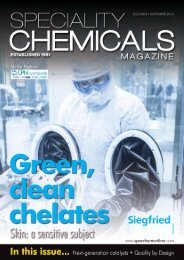G20-Germany-Hamburg-2017
mo.rami@trmg.co.uk
mo.rami@trmg.co.uk
You also want an ePaper? Increase the reach of your titles
YUMPU automatically turns print PDFs into web optimized ePapers that Google loves.
ADVOCACY<br />
Pamela Phua, Director, RD&I<br />
Exterior Wall Paints Expertise & Research Group, Global<br />
South East South Asia & Middle East<br />
AkzoNobel Decorative Paints<br />
air, resulting in millions of deaths every year. Rapidly<br />
evolving into a global health crisis, worsening air<br />
pollution in the form of thick smog continually engulfs<br />
Asia’s megacities like Beijing and Delhi as well as<br />
Europe’s metropolises such as Paris and London.<br />
To support urban communities to combat<br />
pollution, AkzoNobel embarked on a programme to<br />
deliver next-generation depolluting paint based on<br />
the technology of photocatalysis of titanium dioxide.<br />
By absorbing sunlight, specifically ultraviolet<br />
radiation, photoactive titanium dioxide particles can<br />
be activated in the presence of oxygen and moisture<br />
to produce free radicals. These highly active radicals<br />
are capable of degrading pollutants like nitrogen<br />
oxide and sulphur oxide, thereby contributing to the<br />
abatement of noxious emissions from motor vehicles<br />
and other human activities. However, the radicals<br />
can also decompose organic constituents in the paint<br />
and consequently impair the paint durability with<br />
excessive chalking. This challenging obstacle was<br />
overcome by a specially formulated inorganic film<br />
having a higher resistance to radical attack.<br />
While cleaning up the air, our photocatalytic paint<br />
can also deliver outstanding self-cleaning properties<br />
with low dirt pick-up to building façades. This<br />
eco-positive benefit derives from both the<br />
degradation of the dirt particles by the radicals and<br />
the photo-induced super-hydrophilicity effect, where<br />
the latter is manifested by a water-loving surface that<br />
allows rain to spread readily on the surface, under<br />
the dirt, suspend it and wash it away.<br />
Water-repellent coating<br />
Alternatively, a façade that stays clean can also be<br />
delivered via super-hydrophobicity. To this end,<br />
AkzoNobel are developing an extremely waterrepellent<br />
coating with inherently low surface energy,<br />
enhanced by multi-scale surface topography. In<br />
essence, water beads form and roll off easily, or →
















